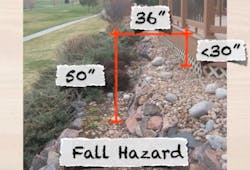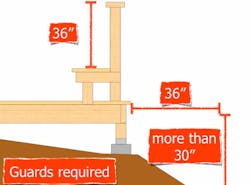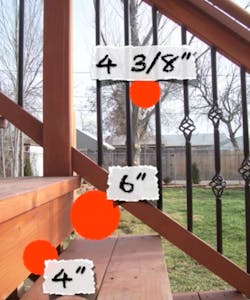Non-Structural Codes for Deck Guards
The non-structural requirements are pretty simple for guard rails: if there's a fall hazard, make a guard, and keep it such that it will actually stop people from falling.
This excerpt from Building Code College covers non-structural guard rail requirements and how to meet them. Building Code College is a series of videos by Glenn Mathewson, a building official in Colorado.
The videos are free to anyone. If you want to become certified or earn CEUs, it will cost a few bucks.
Agenda:
- What is a guard?
- When they are required
- Guard geometry
What it is:
Guard | ɡärd | noun
"A building component or system of building components located near the open sides of elevated walking surfaces that minimizes the possibility of a fall from the walking surface to the lower level."
A guard is different from a stair handrail.
Handrail | ˈhan(d)ˌrāl | noun
"A horizontal or sloping rail intended for grasping by the hand for guidance or support."
Guards can be many things. they can be masonry half-walls, privacy screens, or even outdoor cabinetry. Often, though they take the form of a guard rail along the edge of a deck or porch.
And there are a lot of materials you can make them from. As long as they provide a minimum performance, their design can be unique.
When you need one:
At open sides of walking surfaces greater than 30 inches above grade, measured from a point 36 inches horizontal from the edge.
If the ground below the deck is closer then 30 inches, but sloped away, you may need a guard.
Minimum height:
- 34 inches above stair treads, 36 inches above finished floor for flat surfaces.
- Point of reference: Height of required guards are measured from the walking surface (or adjacent fixed seating for pre-2015 IRC). For pre-2015 codes jurisdictions, fixed seating is only to determine height, not if guards are required
The 2015 IRC no longer has this fixed seating requirement, but previous versions of the code did, so here's the bottom line.
If you build a guard that is 36 inches tall, you have complied with the law. If you then add a bench to the guard that is 18 inches tall, and your jurisdiction is running the 2012 code or earlier, your guard rail may no longer be legal.
Opening size:
The opening size limitation only applies to guards that are required. If you have a guard on a grade-level deck, you can do whatever you want with thew openings.
Up to 36 inches above...
- ...walking surfaces and ramps, the guard cannot allow the passage of a 4 inch sphere.
- ...sides of stairs, the guard cannot allow the passage of a 4-3/8 inch sphere.
- ...sides of stairs above tread, the guard cannot allow the passage of a 6 inch sphere.
Guards that are taller than 36 inches can have unrestricted openings above the 36 inch mark, for example an 8 inch rectangle over two 4 inch squares.
At the end of the day, guards can be any design or construction as long as the performance satisfies your jurisdiction's building code.
—Glenn Mathewson is an inspector/plans examiner in Westminster, CO. This video is excerpted from his Building Code College, a free ICC-approved online school for building codes.


